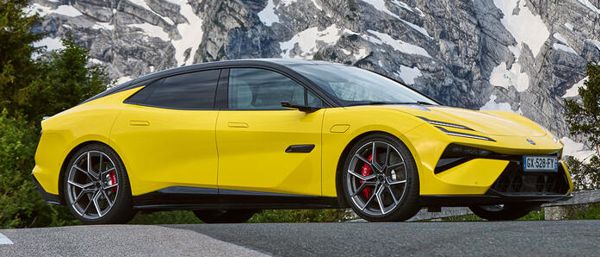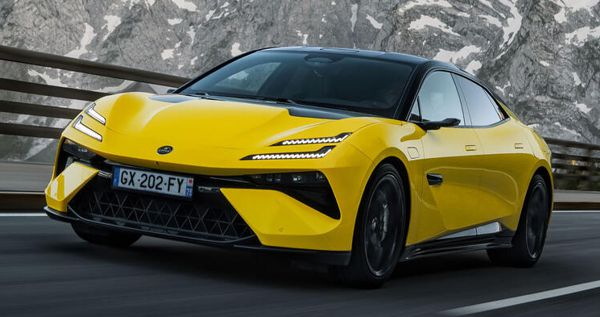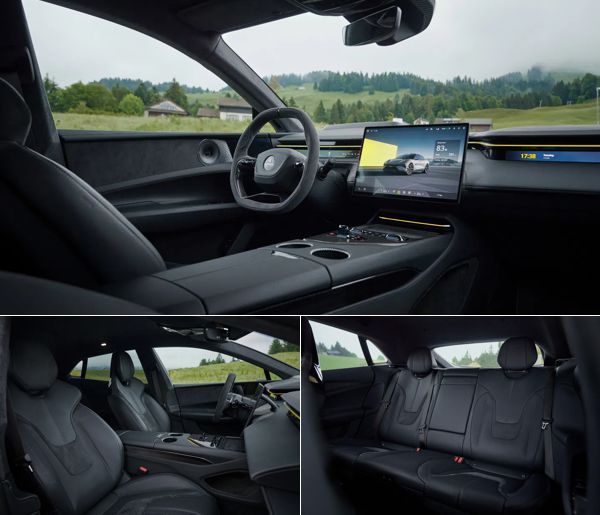| Published
on 14
Aug 2024 |
All rights reserved.
|
|

|
|
Brand
new electric car from a brand new company, Lotus Technology.
|
|
Emeya is a Lotus. No, it
is not built in Hethel. Not designed by the same guys who created
Elise, Emira, Exige and countless of fabulous sports cars. In fact, it
is a product of another company, Lotus Technology Inc., that was
founded by parent company Geely in Wuhan, China. Development of the car
took place in China and assisted by Lotus Tech’s R&D center in
Frankfurt, Germany, which is an ex-Geely facility. Styling was carried
out by the company’s studio in Conventry, UK, under the leadership of
Ben Payne, which is another ex-Geely facility rebranded to Lotus in
recent years. It has nothing to do with Lotus Cars’ studio in Hethel
led by Russell Carr. Doesn’t it sound complicated? Well, that’s the way
Chinese operates things and plays with foreign brands. In short, you
can see Emeya as a new electric car from a new startup, having little
relationship with the legendary British sports car maker.
Geely has great ambition on the expanded Lotus brand. Last year, it
sold 4361 Eletre SUVs and 2609 Emira sports cars, but it is already
aiming at 26,000 units this year and a whopping 150,000 units rolling
off its production line in Wuhan (owned by Geely, as Lotus Tech is void
of factories) by 2028. Undoubtedly, nearly all of those will be the
electric Eletre, Emeya and probably a new Macan-sized electric SUV.
Obviously, the Emeya, codenamed Type 133, is derived from the Eletre
SUV. It is an EV, of course, sharing much the same underpinnings of
that truck. At over 5.1 meters long, it is even longer than that truck.
It weighs a whopping 2.5 tons on base model and rises to 2.6 ton for
flagship Emeya R, equivalent to a Rolls-Royce Phantom! Colin Chapman
might not be impressed if he was still around.
While Chapman strived for adding lightness to his cars in his entire
life, the Emeya has little concern about its own weight. Its monocoque
chassis is a mix of steel and aluminum, unlike the all-aluminum
structures of Lotus sports cars. Its body panels are aluminum sheets
instead of glass-fiber composites. In fact, reading through the press
release, weight-saving measure is mentioned only once, and it is just
the the optional carbon ceramic brakes. Instead, the press talks about
luxury, driving assistance and connected technology, things that don’t
sound like Lotus DNA.
 |
|
Carrying
2.6 tons of weight, it is as heavy as a Rolls-Royce Phantom, or 300kg
more than a Porsche Taycan Turbo.
|
|
The exterior design, while looking aggressive and sporty in some
angles, cannot hide the fact that it envelops a lot of volume. Even
though fitted with 22-inch wheels, the waistline still looks a couple
of inches too high from the ground. The fascia has probably too much
flavors of SUV. The slim, double-L-shape LED headlights are, well, a
bit gimmicky. The rear quarter view is not sufficiently different from
a Toyota Camry unless it has the active rear spoiler raised. Don’t get
me wrong, it is by no means ugly, just not as characterful as we had
hoped for a Lotus. If you remove its badge, it could be just about any
cars from an EV startup. You won’t tell its identity from its shape.
It is a huge car undeniably. Although most of us will see it as a
direct rival to Porsche Taycan, Lotus Tech actually benchmarked it
against Panamera during its development. You know, the Panamera is
easily more spacious than the Taycan and is supposed to be a rival of
Mercedes S-class etc. as a performance luxury limousine. The Emeya
wants to be that as well, so it is given a massive wheelbase of 3069 mm
(169mm more than Taycan) and a very non-sports car height of 1459mm
(80mm taller than Taycan). It is also super-wide at just over 2 meters.
Even without starting to drive the car, you know it is not going to be
as agile as a Taycan.
On the flipside, its cabin is easily more spacious than Taycan, with
acres of legroom in the back and more headroom, too, although the boot
is too shallow to place larger luggage. Obviously, the cabin is largely
carried over from the Eletre SUV – the entire dashboard with ultra-slim
instrument display, the slightly square steering wheel, the prominent
transmission tunnel and the Tesla-style 15-inch infotainment monitor –
the latter is responsive and painless to use. There is also a pair of
screens at the doors to display the images taken from the optional
digital mirrors, which help lowering drag coefficient to 0.21. There
are head-up display, premium sound system and even panoramic glass
roof, or a Lidar-and-camera-based driver assistance system that will
eventually enable self-driving, things you won’t expect on a Lotus.
Meanwhile, build quality is fine, not great, but better than Lotus has
any rights to be.

|
|
Benchmarked
against Panamera, its interior is quite spacious and well-equipped.
With lots of technology, too.
|
|
Unfortunately, although the driver seat is mounted 70mm lower than that
of Eletre, it is still a few inches higher than keen drivers desire,
who will find Taycan far more satisfying. Both cars are built on Geely
group’s EPA (Electric Premium Architecture) platform which is a
development from the SEA platform used by many Polestar, Volvo, Zeekr
and Lynk & Co models. All batteries are placed inside the
skateboard floor. Perhaps that is why it is not so tailored to sports
car requirements.
The EPA runs at 800V and 350kW DC charging. Lotus claims it take 18
minutes to charge the 102kWh battery from 10 to 80 percent, same time
as Taycan does with its slightly larger, 105kWh battery. Regarding
range, the base Emeya is good for 610km, trailing slightly a Taycan 4S
with Plus battery (646km). Unfortunately, range drops significantly to
540km for Emeya S and only 435km for Emeya R. In contrast, the
comparable Taycan Turbo and Turbo S achieve 634km. No match.
What differ the 3 Emeya models? All of them run twin-motor and
all-wheel drive setup. The base car and S use identical front and rear
motors for a combined output of 612 horsepower, accompanied with 524
pound-foot of torque, so there is nothing to separate them in straight
line performance. Both of them tops 155 mph and accelerate from rest to
60 mph in 4.1 seconds, a bit disappointing for an electric performance
car. The base car is already quite generously equipped with all
multi-link suspension on twin-chamber adaptive air springs and
continuous adaptive dampers. The S model gets larger wheels (21-inch),
wider tires and larger brakes. They are priced at £90,000 and
£102,000, respectively. A Taycan 4S with Plus battery is the same
price as Emeya S, but is half a second quicker to 60 mph and travels
106 km longer on a single charge.
Meanwhile, the range-topping Emeya R uses a more powerful rear motor
with its own 2-speed gearbox. Power increases to 918 hp and 726 lbft,
lifting performance to 0-60 mph in 2.75 seconds and 159 mph top speed,
making it one of the fastest production electric cars on the market.
Besides, it is equipped with active anti-roll bars, rear-wheel steering
and carbon-ceramic brakes. Priced at £130,000, it does not go
well against a Taycan Turbo, which is slightly quicker again, travels
200km longer and sold at just £4,000 more.

|
|
Emeya
R's dynamics disappoints, a shame to wear the Lotus badge. S is better.
|
|
On the road, the range-topping R is the one that disappoints most.
While it is hypercar-quick on acceleration, especially from medium to
high speed where the acceleration feels relentless and so strong that
makes you feel uncomfortable, the R feels flawed and compromised in
curves. The addition of rear-wheel steering and active anti-roll bar
does not make the big electric car shrink around you, but creates more
problems than benefits. In medium-speed corner the rear axle steers
inconsistently, like having trouble to decide to steer in sync or in
opposite angles. Just when you lose confidence to press on, the body
roll resulted from the soft suspension is suddenly countered by the
active anti-roll bars, but in an abrupt manner and, worst of all, all
four corners don’t work in sync. You sense they keep adjusting going
into straights, very weird. Now you wonder how a company renowned for
chassis tuning for decades could fail so badly – and then you remember
that this is actually another company whose ride and handling engineers
are based in Germany. Yes, the Emeya R does rides well on Autobahn, but
in everywhere else it sucks!
Likewise, the electric power steering on Emeya R feels like German cars
than Lotus. It is precise but numb, delivering little feedback from the
road ahead. Better is the braking, as the regenerative braking blends
well with mechanical braking for a linear pedal feel. However, even
ceramic brakes may not sustain the abuse on tracks, as the car carries
300 kg more than a Taycan Turbo.
While the R feels nervous or even fearsome to be pushed, the lesser S
is far more benign. With a much simpler chassis its steering and
suspension responses are far more progressive and consistent. The
reduced power is also easier to tame, not threatening to break traction
loose every time you floor down the throttle. It is better balanced,
returning some of the fluidity that makes Lotus’ sports cars famous,
although it will never feel as agile or as communicative. This is
probably the car that received some tuning works from the engineers of
Hethel.
Still, the Taycan 4S is superior in driver appeal, sportier and more
engaging. Better looking and considerably more efficient to travel. The
big Lotus wins only in terms of cabin space and value for money, as it
offers more standard equipment. For pretty much a startup, that’s not
enough to catch attention. While Geely has great ambition on Lotus
Technology, there are plenty of signs that it is very likely to miss
the original targets. The path to success in the luxury / sports car
segment has never been easy for newcomers. Geely will learn that soon.
|
Verdict: Emeya
/ Emeya S:    ; Emeya R:
; Emeya R:   |
|